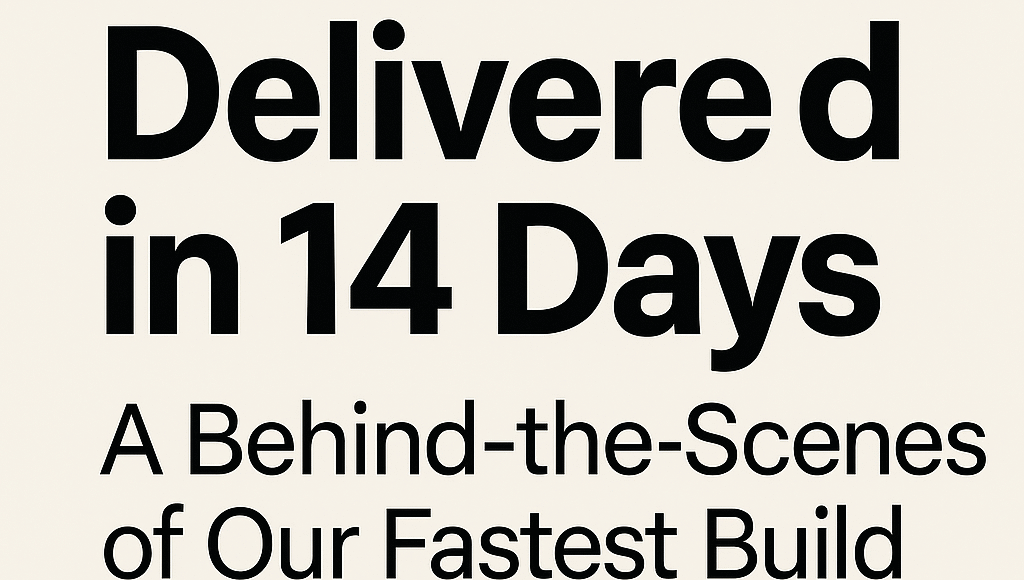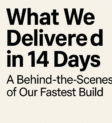What We Delivered in 14 Days: A Behind‑the‑Scenes of Our Fastest Build

What We Delivered in 14 Days: A Behind‑the‑Scenes of Our Fastest Build Completing a fully functional MVP in just 14 days felt almost surreal—like sprinting a marathon. Yet it wasn’t luck; it was the outcome of sharp focus, intentional structure, and a shared drive. Here’s what we delivered in 14 days, weaving together lean and agile frameworks to deliver exceptional quality against the clock.

Day 0–1: Laying the Foundation
From the moment we committed to the two‑week timeframe, clarity was everything. We gathered all stakeholders—product leads, developers, designers, and QA—and defined not only what features we would build, but also how we would measure success. That meant identifying our North Star metric and setting SMART goals to align expectations. By the end of day one, everyone had internalized the mission: “One week to build, three days to refine, two days to test and deploy.” This unity of purpose eliminated ambiguity and focused our energy.
Day 2–8: Immersive Daily Flow
The next seven days became a rhythm of disciplined execution. Each morning began with a crisp 15‑minute stand‑up where we shared progress, raised concerns, and re‑aligned priorities. Immediately after, we dove into 90‑minute uninterrupted work blocks, each targeting a specific feature. This time‑boxing helped eliminate multitasking and choppy attention. In the afternoon, quick syncs kept momentum alive, and we closed the day with informal demos to showcase completed work. This cadence balanced autonomy and alignment, ensuring rapid progress without losing coherence.
Behind the scenes, our version control strategy—feature branches, pull requests, and continuous integration—meant each merge triggered automated builds and tests. Designers and developers collaborated in real time, using Slack and live prototypes to cut down feedback loops, echoing extreme programming practices.
Day 9–11: Feature Freeze and Visual Polish
On day nine, we hit feature freeze—no more additions or scope creep. For the next three days, the entire team shifted gears toward refinement. Our designers standardized typography, spacing, and visual motifs across all screens, creating a cohesive and polished aesthetic. Developers optimized performance by bundling CSS, compressing images, and enabling lazy loading. Meanwhile, QA built staging environments to mirror real‑world usage and gather early feedback. This fast feedback cycle mirrored agile’s core principles.
Day 12–13: Intensive QA and Testing
Quality assurance took center stage as QA engineers ran smoke tests across core user flows, ensuring nothing broke—from signup to feature usage. Regression testing ruled out unintended consequences, while cross‑device checks verified consistent behavior on mobile, tablet, and desktop. Every identified bug was triaged, fixed that day, and re‑tested by evening—closing the feedback loop within hours. This parallel development and testing ensured pace without compromising stability.
Day 14: Launch Day
Launch day was a finely choreographed crescendo. In the early hours, we conducted final sanity checks on staging, verifying integrations and monitoring performance metrics. Mid‑day, we tagged the golden release, deployed to production, and ran a fresh round of smoke tests to ensure reliability under real user conditions. Shortly after, we rolled out a soft launch to internal teams and trusted beta users, gathering immediate feedback. By afternoon, we announced publicly what we delivered in 14 days—a polished, user-ready product—emphasizing our “14-day sprint” as a prime example of disciplined, rapid delivery.
What We Learned
Throughout the sprint, several lean and agile philosophies guided us. We eliminated waste by strictly avoiding unnecessary features and documentation, staying laser‑focused on outcomes. Decision‑making was deferred until data was available, preventing premature commitments. Empowering the team to self‑organize fostered ownership, speeding decisions without micromanagement. And by structuring our two‑week initiative into daily time‑boxed cycles, we ensured visible and predictable progress.
Final Thoughts
Achieving our fastest-ever product build wasn’t about recklessness—it was about clarity, discipline, and making every moment count. What we delivered in 14 days wasn’t just faster—it was thoughtful, tested, and human-centered. By merging lean thinking, agile iteration, extreme programming techniques like continuous integration and tight feedback loops, we delivered an MVP on time and with pride.
If you’re tackling a similar challenge, here’s our advice: set a clear vision, break work into focused chunks, integrate often, test early, and celebrate small wins to sustain team spirit. When speed and quality align, magic happens.



